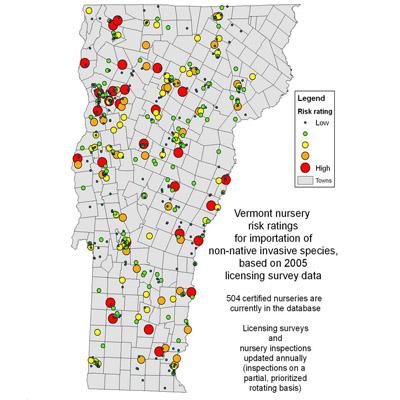Pest Risk Assessment to Aid in Management of Exotic Species Posing Threats to Sustainable Forest Ecosystems

Invasive exotic species, such as the hemlock woolly adelgid (HWA), have potential to rapidly and forever change forest ecosystems. Hemlock woolly adelgid, an insect pest currently threatening to enter Vermont at its southern border, is a danger to hemlock trees in the Northern Forest. Hemlocks provide wildlife wintering areas by reducing snow depths and moderating temperatures. Death of hemlock trees would alter forest structure and expose wildlife to harsh winter extremes.
To assess the threat of the adelgid to Vermont, NSRC researchers used GIS (geographic information systems) and satellite imagery to create maps showing probable hemlock distribution in the southern four counties of Vermont. They mapped all known deer wintering areas in those counties and rated them for susceptibility and vulnerability to HWA. Locations of licensed nurseries and seasonal residences which could contribute to introduction of infested hemlock were mapped for the entire state. Maps showing vulnerability of hemlock areas to impact by HWA based on site productivity, soil moisture, and site aspect were also created for 12 of Vermont’s 14 counties. Wintering areas near the Connecticut and West Rivers were determined to be at the greatest risk of impact by HWA.
This risk mapping assessment serves as a first line of defense in pinpointing hemlock forests most susceptible to infestation by HWA and vulnerable to impact by the pest. These methods can be carried over to other states or regions and used to focus on prevention, early detection, monitoring, and impact assessment of and rapid response to other invasive exotic species that threaten forests and agricultural crops.
Download printable version [PDF]
Download full final report [PDF]
